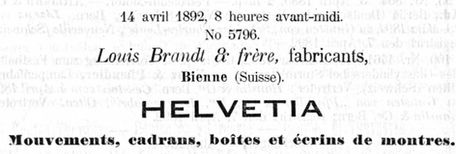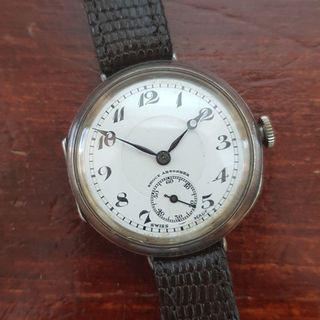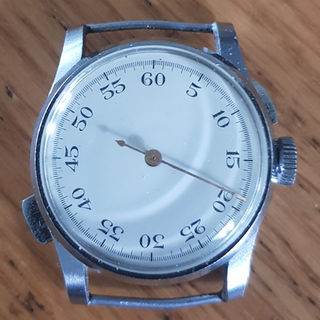
The History of The Helvetia Watch Company
Helvetia's history ranges from its beginnings alongside Omega at Louis Brandt & Frere to the Swiss 'Quartz Crisis' of the 1970s & 80s and beyond.
Scroll down to read more...
On the 14th April 1892 the Swiss watch company Louis Brandt & Frere registered the name ‘Helvetia’ as one of the brand names for their watches. Two years later in 1894 they also registered the name ‘Omega’ and applied it to a new range of high quality lever movement pocket watches they had developed using cutting edge manufacturing technology.
La Générale watches were often marked on the dial and case ‘La Générale, Successeur de Louis Brandt & Frere’ and it looks as if the Brandts were using the pull of their famous name to move the customers of their non-Omega watches over to La Générale allowing them to concentrate on Omega. Indeed, in 1903 they renamed their company from Louis Brandt & Frere to ‘La Société Anonyme Louis Brandt & Frere (Omega Watch Co)’. Also in 1903 first Louis Paul and then César Brandt died and, though Adrien Brandt replaced them as a director of La Générale for several years, in 1911 the Omega Watch Co finally withdrew from La Générale and those brand names in use by them that were still registered under Omega were officially transferred.

Following the withdrawl of Omega, Edouard Boillat transferred the rest of the company Ed. Boillat & Cie to the control of La Générale including his factory at Reconvilier to allow him to concentrate on his metal foundry business.
In the years since 1895 La Générale had begun to make better quality lever movement watches, sold mainly under the Helvetia name, and in 1906 they built a new factory in Bienne with offices and workrooms for 104 workers. Here they developed a 13 ligne movement that was used in smaller fob watches and then in their first wristwatches around 1907. They also registered brand names in their own right such as General in 1902, Adonis in 1905 and Orta in 1911.
The start of the first world war in 1914 signalled some major changes to the Swiss watch industry. The need to be able to tell the time quickly and easily in the trenches without fumbling for a pocket watch meant that wristwatch use and production rose rapidly and the poor conditions that a watch was liable to meet also meant that water and moisture resistance became more important. La Générale appears to have started to specialise in watches with this type of protection around this time. They had actually developed a screw case, swing ring, pocket watch with water resistant properties by 1903 and during the war a large percentage of their wristwatches were of the hunter or half hunter types that included a hinged lid to protect the face of the watch from damage. They also provided adapted pocket watches for use in German aircraft cockpits and sold watches under the brand names Kitchener and Les Poilus (a nickname for French troops) in allied countries.
La Générale finished the first world war in a strong position. They valued their company at 1,000,000 Swiss Francs in 1920 more than double the pre-war value. During the 1920s they continued their specialism into so called protected watches; a report on the 1920 Swiss Watch fair mentions “Among other original creations we notice the miner's watch, of an exceptionally robust construction and completely impermeable.” By about 1924 they had also started to produce watches with shock protection, which was very unusual at the time and initially appears to have been a version of the Depollier/Brun shock protection system patented in 1921.
This was the time La Générale also began to use the English version of their company name, General Watch Co, prominently in their advertising and push the brand name Helvetia to the fore. Though they did occasionally manufacture watches under some of their other brand names such as General or Post almost all the watches they produced from the late 1920s bear the name Helvetia.
These developments came together in 1929 with the production of the Helvetia waterproof and shock protected watch. This watch combined the General Watch Co’s own newly patented shock protection system in a brand new 10.5 ligne movement, the calibre 81, and a water protected silver case with gaskets in the stem and case back. To accompany the new watch a new Helvetia logo was added to the dial though it wasn’t officially registered until 1931, before this a flowing script had been used for Helvetia watches up to about 1908 and plain block capitals from then.
Helvetia continued to develop their water and shock protected watches throughout the 1930s; for instance they patented a waterproof crystal fitting in 1931 and an anti-shock movement mounting in 1933 with a centre sweep seconds version being introduced in 1935. During this period they are regularly mentioned in the UK Horological press as specialising in this area. The following example is from the April 1934 edition of Watch and Clock Maker:
"The 'Helvetia' makers differentiate between their 'shockproof' and 'unbreakable' models, where, perhaps, others confuse the two terms and consequently confuse the trade and their wearers ...The firm hold important patents on each type. The Helvetia waterproof is a very sound job and has stood up against tests that have sent many another watch to a watery grave."
In 1932 they registered a design for a watch with a date window at 12 o’clock and this resulted in the world’s first ‘Big Date’ watch using the Helvetia calibre 75 movement, they also patented a ’stop seconds’ chronograph in 1940 but perhaps the reason that the Helvetia brand is most widely known today is for their pilots’ watches. The General Watch Co first introduced their version of the ‘1928 pattern’ pilots’ watch in 1932 and introduced their famous spinning propeller logo in January 1933 making thousands of these watches up to 1945.
The inter war years were not a happy time for the Swiss watch industry however with a host of small companies in competition with each other in a smaller market and price rises and crashes were common. To try to stabilise the market the Swiss government and banks encouraged, and supported with loans, the formation of ‘Allgemeine Schweizerische Uhrenindustrie AG’ (AUSAG) a group of watch movement and component manufactures that would work together in concert to keep prices and production stable and prevent over production and price fluctuation. Another major group of watchmaking companies was also formed at this time; 'Société Suisse pour l'Industrie Horlogère' (SSIH) was created by Omega and Tissot with an agreement not to compete in the same market segment.
The General Watch Co’s innovations during this period helped them to weather this storm without becoming a part of one of these organisations, and their products remained in demand. Though, as mentioned, they tended to brand their own watches as Helvetia their innovative watches and movements were often sold to other manufacturers and distributers and bear a variety of these companies’ names. There are Helvetia waterproof watches branded Aero, Aeroplane, Huber and Abercrombie & Fitch; big date watches branded Ditis, Mimo, Girard Perregaux and Angora; pilots’ watches branded Aero, Helbros, Huber and Savoy and the Helvetia calibre 81 and 82, calibre 75 rectangular movement and calibre 32 pocket watch movement were also widely used by other firms. I’m discovering General Watch Co. movements in watches from other watch suppliers all the time.
The second world war was another time of expansion for the company. They supplied pocket watches to the British and the German armies and wristwatches to the German and, at the end of the war, US armies, as well as specialist wrist timers to the Royal Navy. By the late 1940s, as at the end of the first world war, the General Watch Co’s value had doubled from a low of 350,000 Swiss Francs in 1938 to 700,000 by 1948. It was also in 1948 that they again decide to change their name this time to ‘Montres Helvetia Société d'Horlogerie La Générale’ and from this date onwards they are usually referred to as Montres Helvetia S.A. or the Helvetia Watch Company.
Following the war Helvetia carried on making military style watches as the demand from ex-servicemen remained high but in the later 1940s they turned some of their capacity to producing some high quality, and large for the time, wristwatches including solid gold wrist examples something they had not done before the war. In 1947 the British agency for Helvetia was placed with Elco Clocks and Watches and in an article announcing this the Horological Journal noted that:
"Founded in 1895 at La Chaux-de-Fonds, the firm grew rapidly in fame and size , exporting it's watches to every market in the world. The Helvetia factories are among the best laid-out and equipped in an industry which is now an example to the world of efficient factory planning and production ... the output is good in quality and style, and particularly in value".
During the 1950s they again became quite innovative with some interesting dial and case designs and began to develop their own automatic movements, they even brought back their pilots watch for a short time during the mid 1950s. Their Registered Office moved in 1954 to their Reconvilier factory and the smaller Bienne site probably closed at this time. Some idea of the quality of Helvetia watches of the 1950s can be seen from the following extract of a review of the Helvetia 837 movement in the August 1955 edition of the Horological Journal:
"The new Helvetia automatic '837' is a very fine example of a modern high-grade automatic wristlet movement, and is quite characteristic of the high standard that is to be expected in the products of this well-known Swiss factory. It is obvious that the designers have studied the special needs of an 'automatic,' and have not merely adapted a standard type of wristlet movement by the addition of an automatic winding mechanism, for there is nothing in any way makeshift about the lay-out ... it is to be hoped that we shall see many of these excellent automatics arriving on the British market, for they are certainly one of the finest products of the Helvetia factory. The 'automatic' is a type of watch that is going to be even more popular, and this model is one of the best of its kind."
The 1960s were the beginning of another difficult time for the Swiss watch industry with cheaper Japanese imports starting to bite into their market. In an attempt to modernise a new Helvetia logo was adopted in 1963 and adapted slightly in 1965, model names were also added from this time such as Waterstar and Cosmotimer.
.
.
Despite this, Helvetia’s watches, while still high quality, were not very different to any of the other Swiss manufacturers of the 1960s and they too began to struggle. Eventually in 1968 Helvetia became one of the founding members of the Société des Garde-Temps S.A. or SGT alongside Avia, Degoumois & Co., Silvana, Eugene Vuilleumier, William Mathez and Fleurier.
SGT was formed in order to allow the member companies to reduce costs by pooling administrative, research and design functions, rationalising factory space and compete alongside larger competitors with their increased buying power.
Part of this rationalisation involved the move of the Silvana watch company’s offices from Tramelan to the Avia company site in Neuchâtel in 1971, and indeed in 1972 Avia actually changed its name to Avia & Silvana S.A. This move made room for the Helvetia management and administration to move to Tramelan and take over the Silvana factory though they also retained their factory at Reconvilier.
Though Helvetia kept its factory it seems that their in house movement capability was a casualty as from this time Helvetia watches are mostly fitted with adapted ETA movements.
In 1972 Montres Helvetia Société d'Horlogerie La Générale officially changed its name to Montres Helvetia S.A. dropping the name La Générale or General Watch Co. that it had retained since its formation in 1895. Another company named the General Watch Holding Co. had been formed the year before as part of AUSAG. This was a completely different company that had no links with La Générale or Helvetia but possibly Helvetia thought it best to avoid confusion by dropping the La Générale part of its name.
At the annual general meeting of Helvetia S.A. on 16th February 1973 it was decided to dissolve the company! This was not the end for the Helvetia name however as on the same day Silvana S.A. held its own annual general meeting, and Silvana S.A. changed its name to Helvetia S.A.
This appears to be further rationalising within SGT, the chairman and most of the board of both companies were the same and this was obviously a planned progression as shown by the move of the companies registered offices and the fact that Avia had already renamed itself to Avia & Silvana the year before so the Silvana name, lost when Silvana renamed itself to Helvetia, was safe. Perhaps it was decided to keep the assets of Silvana but retain the Helvetia name or perhaps dissolving Helvetia released some much needed capital which dissolving Silvana wouldn’t have done.
How much this actually affected the running of the various factories within SGT I’m not sure as the Silvana management had already moved and joined Avia and the old Silvana factory at Tramelen was already being run by Helvetia at this time. It looks like it was pretty much a paper exercise with everyone staying in their jobs and just their employer changing to Silvana though immediately adopting the name Helvetia! Something in the manufacturing process does appear to have changed though as in 1973 Helvetia changed the format of its serial numbering and this looks likely to have been to do with the demise of Helvetia S.A. and the renaming of Silvana.
Helvetia watches, however, continued to be produced and on 13th June 1975 the Helvetia logos which were still registered to the now defunct Montres Helvetia Société d'Horlogerie La Générale were officially transferred to the new Montres Helvetia S.A. (previously Silvana).
Things were still difficult for the Swiss watch industry however and in 1979 further streamlining was required; it was reported that the Helvetia management was to move to La Chaux-de-Fonds, the remaining staff at the factory at Reconvilier to join their colleagues at Tramelan and the Reconvilier factory close.
SGT could not hold off the Japanese onslaught indefinitely though and in the early 1980s it broke up with its brands being sold off. By 1982 the Helvetia factory at Tramelan had closed and there was a newspaper story that Alpina International S.A. had acquired the empty building and was to build Helvetia watches there. Whether anything came of this I’m not sure but during the 1980s new brand names were registered in Helvetia's name and adverts appeared that mention a relaunch with a new logo to accompany them but this didn’t seem to last long.
Though the derelict Reconvilier factory was demolished in 1993 the logos and trademarks associated with Helvetia were renewed through the 1980s and 1990s and it still survives today, though at a much smaller scale. If you look up current company information for Montres Helvetia S.A. you will find that they are officially based in Zug, Switzerland but actually operate from a jeweller in Vienna, Austria and they still sell some watches with the Helvetia logo. The company's registration shows that it was formed in 1923 which is the date Silvana was formed as, of course, the modern day Montres Helvetia S.A. is really Montres Silvana S.A. So while it is a shame that Montres Helvetia Société d'Horlogerie La Générale did not survive through to the modern age at least one of the old Swiss firms continues and keeps the name alive.
I have spent a lot of time researching this page. Much of the information about the relationship between Omega and La Générale and about the General Watch Co and Helvetia on the internet is incorrect. Hopefully I’ve put a couple of myths to bed:
La Générale was not the original name of the Omega Watch Company or their predecessor Louis Brandt & Frere (despite what Wikipedia says), the company was previously called Louis Brandt & Fils. I think the confusion comes from early La Générale watches being marked 'Successeur de Louis Brandt & Frere' which, of course, means following on from not preceding. Omega was never a La Générale brand either but the Helvetia brand name was registered originally by Louis Brandt & Frere. The two companies, Louis Brandt & Frere and La Générale, though always separate, were both owned by the Brandt brothers.
The General Watch Co. formed in 1895 was not the General Watch Co. that was part of AUSAG from 1972, they were two completely different companies. The AUSAG General Watch Co was originally registered as the General Watch Holding Co. Therefore Helvetia/La Générale/General Watch Co was never part of AUSAG. 1970s watches marked General Watch Co are not made by Helvetia, which was part of SGT by this time, but by the General Watch Co that was part of AUSAG. Not confusing at all!
Waterproof pocket watch and Dynotron watch with thanks to Simon Hollins
WW1 cockpit watch with thanks to Konrad Knirim. Please check out his excellent books here - Military Timepieces
Helvetia 1930s Pilot watch with thanks to German Polosin Ltd - Please have a look at their site here https://german242.com/en/










































